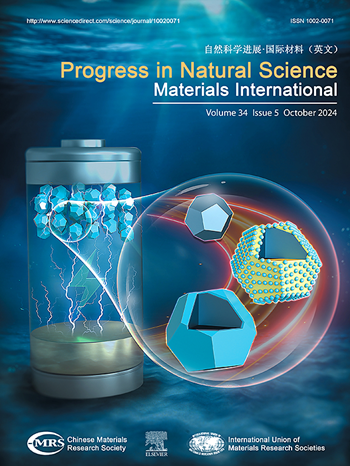Giant improvement in piezo-photocatalytic capability of colloidal g-C3N4 quantum dots
IF 7.1
2区 材料科学
Q2 MATERIALS SCIENCE, MULTIDISCIPLINARY
Progress in Natural Science: Materials International
Pub Date : 2025-08-01
DOI:10.1016/j.pnsc.2025.04.005
引用次数: 0
Abstract
Piezo–photocatalysis has emerged as a promising strategy for addressing energy and environmental challenges by synergistically harnessing light and mechanical energy. In this study, colloidal g-C3N4 quantum dots (QD) are synthesized via a high-power ultrasonic exfoliation method and have demonstrated significantly enhanced piezo–photocatalytic performance. Key factors for performance enhancement include reduced size, enhanced surface effects, and the introduction of oxygen doping and nitrogen vacancy, which improve the separation efficiency and lifetime of photogenerated charge carriers. These enhancements enable exceptional photocatalytic and piezo–photocatalytic degradation efficiencies, achieving 99.9 % degradation of methylene blue within 20 min under 365 nm light irradiation combined with ultrasonic assistance. Furthermore, in-situ electron spin resonance measurements reveal the abundant generation of ·CH2OH radicals in melamine-derived g-C3N4 QD, highlighting its potential for applications in photocatalytic organic synthesis. The colloidal QD exhibit remarkable long-term stability and reusability, with minimal performance decline over multiple cycles. This work elucidates the mechanisms underlying the performance enhancements of g-C3N4 QD and underscores their potential for practical applications in environmental remediation and sustainable energy conversion.
胶体g-C3N4量子点压电光催化性能的巨大提高
压电光催化通过协同利用光能和机械能,已经成为解决能源和环境挑战的一种有前途的策略。本研究采用高功率超声剥离法合成胶体g-C3N4量子点(QD),其压电光催化性能显著增强。性能增强的关键因素包括尺寸的减小、表面效应的增强以及氧掺杂和氮空位的引入,这提高了光生载流子的分离效率和寿命。这些增强功能实现了卓越的光催化和压电光催化降解效率,在365 nm光照射结合超声波辅助下,在20分钟内实现99.9%的亚甲基蓝降解。此外,原位电子自旋共振测量显示,在三聚氰胺衍生的g-C3N4 QD中产生了大量的·CH2OH自由基,突出了其在光催化有机合成中的应用潜力。胶体量子点表现出显著的长期稳定性和可重用性,在多次循环中性能下降最小。这项工作阐明了g-C3N4 QD性能增强的机制,并强调了它们在环境修复和可持续能源转换方面的实际应用潜力。
本文章由计算机程序翻译,如有差异,请以英文原文为准。
求助全文
约1分钟内获得全文
求助全文
来源期刊
CiteScore
8.60
自引率
2.10%
发文量
2812
审稿时长
49 days
期刊介绍:
Progress in Natural Science: Materials International provides scientists and engineers throughout the world with a central vehicle for the exchange and dissemination of basic theoretical studies and applied research of advanced materials. The emphasis is placed on original research, both analytical and experimental, which is of permanent interest to engineers and scientists, covering all aspects of new materials and technologies, such as, energy and environmental materials; advanced structural materials; advanced transportation materials, functional and electronic materials; nano-scale and amorphous materials; health and biological materials; materials modeling and simulation; materials characterization; and so on. The latest research achievements and innovative papers in basic theoretical studies and applied research of material science will be carefully selected and promptly reported. Thus, the aim of this Journal is to serve the global materials science and technology community with the latest research findings.
As a service to readers, an international bibliography of recent publications in advanced materials is published bimonthly.

 求助内容:
求助内容: 应助结果提醒方式:
应助结果提醒方式:


